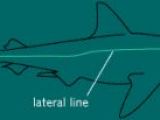Fishes possess a special complex organ, called lateral line, stretching along their flanks, which detects movement and vibration in the surrounding water environment.
This organ helps them find prey and avoid predation in murkier waters and guide them for synchronized swimming, obstacle avoidance, and tracking.
The best swimmers (like sharks and tunas) have this organ extremely well developed while some bottom fishes or weak swimmers may lack it.
Recently, a team led by Chang Liu at the University of Illinois at Urbana-Champaign has made an artificial lateral line for underwater vehicles. "Our development of an artificial lateral line is aimed at enhancing human ability to detect, navigate and survive in the underwater environment," said Liu, a professor of electrical and computer engineering. "Our goal is to develop an artificial device that mimics the functions and capabilities of the biological system."
The new type of underwater vehicle could detect and track moving underwater targets, and also avoid collisions with underwater mobile or still objects.
The artificial lateral line imitates the biological one, being made from an integrated linear array of micro fabricated flow sensors.
The sensors' sizes (400 microns wide x 600 microns tall) and spacing (1 mm) are similar to the biological structures, coming in arrays of 16. "By detecting changes in water pressure and movement, the device can supplement sonar and vision systems in submarines and underwater robots," said Liu.
The components of the lateral line are cast on sacrificial layers, employing techniques like photolithography and planar deposition.
Magnetic material is electroplated onto each of the parts, which are then released from the substrate by an etchant. A magnetic field triggers the pieces to spin out of the plane on mini-hinges and lock into place. The sensors are connected to a metal-oxide-superconductor circuitry, which decreases noise and keeps the data.
The artificial lateral line can localize nearby underwater vibrations and their source, and picks up the hydrodynamic wake (like that left behind by a propeller-driven submarine) for long-distance tracking. "With further advances in engineering, man-made underwater vehicles should be able to autonomously image hydrodynamic events from their surroundings," Liu said.
"Although biology remains far superior to human engineering, having a man-made parallel of the biological system allows us to learn much about both basic science and engineering. To actively learn from biology at the molecular, cellular, tissue and organism level is still the bigger picture."

 14 DAY TRIAL //
14 DAY TRIAL // 
